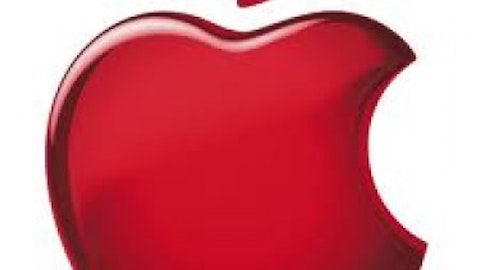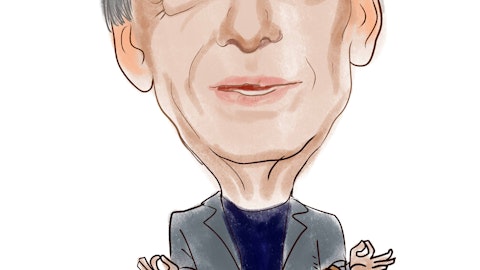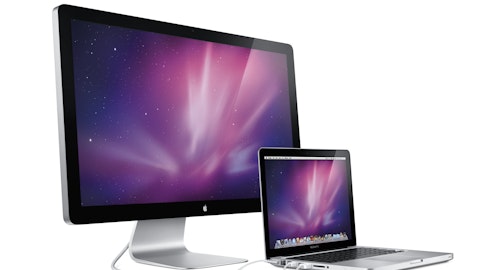Apple Inc. (NASDAQ:AAPL) makes a bevy of tech products, and while many would assume that each product has an equally important effect on the company’s bottom line, that’s simply not the case. Yesterday, we discussed just how important the iPhone was to Apple’s bottom line, estimating that a whopping two-thirds of the earnings are generated from sales of the device (see The Real Reason You Should Be Buying Apple).
Keeping this in mind, then, we can understand why iPhone sales figures are of special importance this holiday season, particularly of the iPhone 5. On average, Wall Street expects Apple to sell close to 45 million total iPhones in its fiscal first quarter, which is near 20% growth from the 37 million units it sold in Q1 FY2012.
Now, we must remember that Q1 FY2013 is one week shorter than last year, so in fact, we can stretch this adjusted growth rate out to 30%. An easy way to imagine this calculation is to break down sales in weekly amounts. In Q1 FY2012, Apple Inc. (NASDAQ:AAPL) sold an average of 2.64 million iPhones per week, which amounted to 37 million over a 14-week period. This current quarter, Apple is expected to sell an average of 3.46 million iPhones per week, which multiplied over 13 weeks gives us our 45 million-mark.
Now, the reason we mention these numbers is because Jon Fortt, CNBC’s Technology Correspondent, was on the network’s “Markets Now” segment earlier this week discussing the fate of Apple Inc. (NASDAQ:AAPL) and the iPhone in particular. On the subject, Fortt had this to say (emphasis added):
“Two conflicting story-lines on Apple collided […] one has Apple ordering fewer iPhone 5 parts, which has some investors worried about a less than stellar start to 2013. The other has Apple turning in a strong opening weekend of iPhone 5 sales in China, suggesting demand remains strong in Apple’s most crucial growth market for the iPhone. The overriding question here is: are we at the beginning of a radical global slowdown in growth for the iPhone and iPad? About a half a dozen analysts seem to think so […] Cannacord, Citi, Mizuho, Pacific Crest, and UBS have all cut their price targets in recent days. The idea is that Apple is ordering fewer parts for the months after the holidays”
After mentioning the lowered price targets on Apple Inc. (NASDAQ:AAPL) – the five of which average $638 ($750 high, $565 low) – Fortt mentions that slower post-holiday iPhone parts orders “frankly isn’t that unusual,” adding that “the problem with this theory though: demand still looks pretty strong for the iPhone 5.”
While it’s obviously important to take analysts’ recommendations into account, we’d have to agree with Fortt that fewer parts orders isn’t a true reason to be bearish, and honestly, we’re encouraged by the 30+% growth that is expected in terms of total iPhone sales this quarter. Apple’s year over year growth rate in Q1 FY2012 iPhone sales was higher, at over 130%, and Q1FY2011 growth was near 85%, but it’s important to realize that this slowdown shouldn’t be considered “radical.”
After all, if Apple Inc. (NASDAQ:AAPL) is able to meet its growth targets, it will have a great chance at hitting Wall Street’s overall EPS estimates, which expect a consensus of $13.50. When we adjust this figure for the one-week discrepancy, we can see that it represents a 4-5% growth in quarterly earnings. This would go a long way toward helping Apple achieve its year-end EPS of around $49 a share, according to sell-side estimates.
While growth may be slowing a bit, the price-to-earnings ratio indicates that investors are over-discounting for this phenomenon. Apple Inc. (NASDAQ:AAPL) currently trades at a PEG of 0.62, which is far below that of Google Inc (NASDAQ:GOOG) (1.44), and Microsoft (NASDAQ:MSFT) (1.55). In fact, we’ve seen a lot of chatter that investors may be better off investing in key Cupertino suppliers like Cirrus Logic Inc. (NASDAQ:CRUS) or Qualcomm (NASDAQ:QCOM), but both actually trade at earnings growth valuations an average of twice as high. Cirrus’ PEG is 1.01, while Qualcomm’s is 1.46.
While this seems a bit simplistic, the overall logic behind this way of thinking checks in with how Apple Inc. (NASDAQ:AAPL) investors should be trading the stock. In reality, we’re fickle, sometimes irrational creatures, who are tempting to change our investment theses based on metrics that aren’t fundamental to a stock’s growth. Based on what we’ve discussed above, the overall picture for the iPhone 5 looks strong despite a few price target cuts Apple has received.






